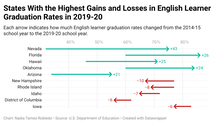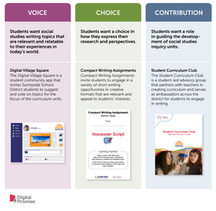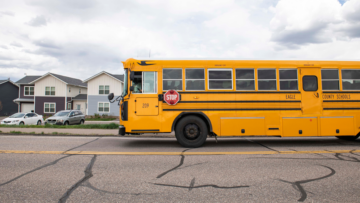Exactly how much of a gap exists between native English speakers and English learners depends on the state. In Indiana and Florida, graduation rates for English learners are approaching 90 percent and almost on par with the overall student population. The worst state for English learners is New York, where only 39 percent of them graduated compared to 83 percent of students overall.
New Mexico, for example, ranks 10th in graduation rates for English learners, which is nearly on par with rates for their peers who are native English speakers. The federal data shows a 77 percent overall graduation rate in the state and 76 percent for English learners.
Kirsi Laine, who leads the Student, School & Family Support Bureau at the New Mexico Public Education Department, says supporting English learners starts with identifying them through screenings for language proficiency. The specifics depend on their needs and the school they attend, she adds.
“If a student is actually identified as an English learner, we do make sure that there is an EL program that supports their language development or language acquisition,” Laine explains. “That EL program piece is really serving to ensure that there’s access to the English language so that when the student is in other classes, that they can access that content.”
Laine and Valtierrez attribute the state’s results to policies that took root in 2012, starting with a roadmap for English learner success that was boosted by a federal law aimed at closing gaps three years later. Even before that, New Mexico was the first state to adopt policies supporting bilingual and multicultural education, Valtierrez says, with 2023 marking the 50th anniversary of the law.
“The passage of the Every Student Succeeds Act, that really gave us an opportunity to really lean into some of the specific items that Kirsi shared, like a uniform way of identifying who the [English learner] students actually are, and what’s required to serve them,” Valtierrez says. “And also, let’s be really specific about how there is nothing wrong with our students. They come as they are, and we’re here to support them and be responsive to them.”
There was also “mindset work” done among adults, Valtierrez explains, to ensure that academic subject classes were not watered down due to a perceived language barrier.
“Learning English is a journey, but that doesn’t have to have anything to do with what we’re taught,” Valtierrez says. “Really, it was a lot of mindset work, ensuring that students are given an opportunity to understand why they’re assessed on language, and how that differs from being assessed on content.”

Despite dismal numbers in some parts of the country, graduation rates among English learners have been steadily improving since 2010-11, when there was a national 10-year low of 57 percent. The national graduation rate for emergent bilinguals was 71 percent in 2019-20.
Over the five most recent years of data, Nevada made the biggest improvement in graduation rates for English learners, with an increase of 43 percentage points since 2014-15. Its English learner graduation rate for the most recent available year was 75 percent in 2019-20. New Hampshire saw the biggest decline, falling by 10 points since 2014-15 to 67 percent emergent bilinguals graduating in 2019-20.
- SEO Powered Content & PR Distribution. Get Amplified Today.
- PlatoData.Network Vertical Generative Ai. Empower Yourself. Access Here.
- PlatoAiStream. Web3 Intelligence. Knowledge Amplified. Access Here.
- PlatoESG. Carbon, CleanTech, Energy, Environment, Solar, Waste Management. Access Here.
- PlatoHealth. Biotech and Clinical Trials Intelligence. Access Here.
- Source: https://www.edsurge.com/news/2023-10-04-how-many-english-learners-graduate-from-high-school-it-depends-where-they-live
- :is
- :not
- :where
- 10
- 10th
- 2012
- 2023
- 39
- 67
- 75
- 77
- 90
- a
- About
- academic
- access
- acquisition
- Act
- actually
- Adds
- adopt
- adults
- aimed
- almost
- also
- among
- an
- and
- anything
- approaching
- ARE
- AS
- assessed
- At
- attend
- available
- barrier
- BE
- been
- before
- being
- between
- Biggest
- Boosted
- Bureau
- but
- by
- CAN
- classes
- closing
- come
- compared
- content
- country
- data
- Decline
- Department
- depends
- Development
- do
- doesn
- done
- down
- due
- ed
- Education
- el
- English
- ensure
- ensuring
- Ether (ETH)
- Even
- Every
- example
- exists
- Explains
- Falling
- family
- Federal
- FFF
- fill
- First
- five
- florida
- For
- from
- gap
- gaps
- gave
- given
- graduate
- Hampshire
- Have
- here
- High
- House
- How
- HTTPS
- identified
- identifying
- improvement
- improving
- in
- In other
- Increase
- Indiana
- into
- IT
- items
- ITS
- journey
- landscape
- language
- later
- Law
- Leads
- learner
- let
- like
- live
- Lot
- Low
- made
- make
- many
- marking
- max-width
- Mexico
- Mindset
- most
- much
- National
- native
- nearly
- needs
- NEVADA
- New
- New York
- news
- nothing
- numbers
- of
- on
- only
- Opportunity
- or
- Other
- our
- overall
- parts
- passage
- peers
- perceived
- percent
- percentage
- piece
- plato
- Plato Data Intelligence
- PlatoData
- points
- policies
- population
- Program
- public
- ranks
- Rate
- Rates
- RE
- really
- recent
- required
- responsive
- Results
- roadmap
- root
- s
- saw
- says
- School
- serve
- serving
- shared
- she
- Shows
- since
- So
- some
- Source
- speakers
- specific
- specifics
- Starting
- starts
- State
- Student
- Students
- subject
- success
- support
- Supporting
- Supports
- sure
- T
- taught
- that
- The
- the Law
- The State
- their
- Them
- There.
- they
- three
- Through
- Title
- to
- took
- u.s.
- understand
- us
- visualization
- was
- Way..
- we
- were
- What
- when
- which
- WHO
- why
- with
- Work
- Worst
- Wrong
- year
- years
- york
- zephyrnet











